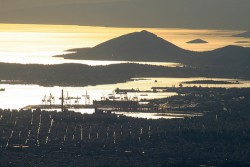Total ascent

Definition of Total Ascent
The Total Ascent of a route is the sum of all vertical meters of those parts of the track that ascents. E.g. climbing twice a mountain of 2000m and coming back to your start point gives you a Total Ascent value of 4000m. Check also net ascent.
Difficulty level (relative)
The Difficulty level is expressed as a value 1/10 (very easy) to 10/10 (very difficult). 1/10 indicates that for this variable there are 90% of the routes more difficult. 10/10 indicates that for this variable there are 90% of the routes more easy.
Frequently asked questions/remarks
Why is it that the height differences (total ascent) is relatively higher than measured with other methods (e.g. GPS)?
There are a few reasons. A few are based on how we measure this variable at RouteYou. A few are based on the method you compare this number too. And the biggest imact is what they call the Coastline paradox:

The effect due to how we measure the heights on RouteYou
- Your track is matched with a height model based on the SRTM digital elevation model.
- We sample your track (+/- every 10m). For that set of points, we extract the height of each point from the SRTM digital elevation model. The densitiy of sampling has an effect on the result, known as the Coastline paradox, first observed by Richardson.
- There are some inaccuracies in the location of your track (typical 5-10m) and on the position of the height information in the digital eleveation model. Just imagine that your track in on a steep slope and you are 10m off, the delta in height info can be quite big.
- Since you calculate the height difference between each sequential pair of points, you get an accumulation and exageration of that effect.
- To reduce that affect, RouteYou applied some filters (smoothing filters). But you don't want to smoothen all the info out.
The effect due to how other sources measure the heights and cumulative heights
- The measurement of height with a GPS is not that accurate if it is only based on satellites. The reason is that when the configuration for the GPS satellites was created, the main focus was on x,y not on z.
- It gets better if the height on a GPS is also based on
- To make sure that the variety of measurement is not too heigh, the providers of GPS height measurement filter (smoothen) the output signal. The more you smooth the output signal of height, the less the number of Total ascent or total descent becomes. It is linked to a classical problem known as the Coastline paradox, first observed by Richardson.